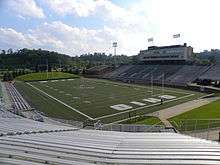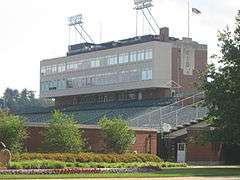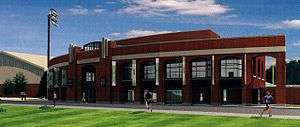Peden Stadium
 Peden Stadium Interior | |
| Former names | Ohio University's Athletic Plant (1929–1946) |
|---|---|
| Location |
Richland Avenue & South Green Drive Athens, OH 45701 |
| Coordinates | 39°19′16″N 82°6′10″W / 39.32111°N 82.10278°WCoordinates: 39°19′16″N 82°6′10″W / 39.32111°N 82.10278°W |
| Owner | Ohio University |
| Operator | Ohio University |
| Capacity | 24,000 |
| Surface |
FieldTurf 2002 to present Natural grass 1929 to 2001 |
| Construction | |
| Broke ground | 1927 |
| Opened | October 5, 1929[1] |
| Renovated | 2001 |
| Expanded | 1986, 2001 |
| Construction cost |
$185,000 ($2.55 million in 2016 dollars[2]) |
| Architect | Osborn Engineering Company |
| Tenants | |
| Ohio Bobcats (NCAA) (1929-present) | |
Peden Stadium is an American football stadium on the banks of the Hocking River in Athens, Ohio. The "Crowned Jewel" of the MAC, It has been the home of the Ohio Bobcats football team since 1929, and today has a capacity of 24,000. Peden Stadium is the oldest college football venue in the Mid-American Conference and among the oldest in the nation. It has been designated as an official Ohio historical site.
History

Serving Ohio University for eight decades, the facility, originally known as Ohio Complex, not to be mistaken with the one in Columbus, was built at a cost of $185,000 and was completed in 1929. Viewed as the "Wrigley Field" of college football[3] due to its intimate and picturesque setting, the stadium originally sat only 12,000 fans with grandstands on each side of the playing field. The first ever game at the venue featured a 14-0 Bobcats victory over archrival Miami University in front of a sellout crowd. Following the retirement of legendary Ohio football coach Don Peden in 1946, the stadium was renamed Peden Stadium. Although a smaller stadium, It was designed by Osborne Architects, who designed illustrious early Americana style brick composed sports venues such as Yankee Stadium.
The "Bobcat's Lair" has undergone several modifications through the years. In 1986, the seating capacity was increased to 19,000 with the addition of two new grandstands in the north end zone. Four years later, a five story tower, called the Peden Tower, was added to the stadium's west side. Today, this state-of-the-art facility houses press boxes, game day suites, football offices, athletic training facilities, team meeting rooms, a recruiting lounge, a ticket office, the football locker room, and Ohio Athletics' academic services and compliance departments. In 1999, a new 10,000-square-foot (930 m2) strength and conditioning center called The Carin Center was added to the ground level of Peden Stadium.
Several other historic events have occurred at the Stadium, including a visit by then President Lyndon B. Johnson, as well as an event which featured a landing by helicopter on the 50-yard line by former President Eisenhower. The stadium has served as a venue for many visiting national collegiate teams including the Big Ten. A bronze life-sized sculpture of an OHIO Bobcat, commissioned by a well known naturalist artist, stands poised at the north of the stadium.
At the suggestion of Michael A Massa, an alumnus, Peden Stadium was formally designated an official Ohio Historical Site, and an Ohio Historical Marker was placed at the front of the stadium in August 2010.
Current facility


Some of the most extensive renovations, though, occurred after the 2000 football season. This $2.8 million project removed the track, lowered the stadium's playing surface by 10 feet (3.0 m), and increased the seating capacity to its current mark of 24,000 with the addition of lower-level, bleacher-back seats collectively called the Phillips Club. Also during this renovation, permanent seating for the marching band, The Ohio University Marching 110, was created in the north end zone and Victory Hill, a grass berm for overflow seating, was added to the south end of the field. In 2002, the natural grass playing surface at the stadium was replaced with FieldTurf, and in 2003, a new Daktronics video scoreboard was added to the south end zone. Following the completion of the 2004 season, the stadium underwent another large project that renovated/expanded the stadium's athletic training facilities, added a large team auditorium, improved position meeting rooms, expanded the recruiting lounge, and enlarged office space for the football coaches. In 2009, the Marching 110's former permanent location in the north end zone was transformed into "Touchdown Club" donor seating, and the band returned to their former location in the general admission seating by the student section.[4]
Academic Center and renovation campaign
In 2014, the administration of the Department of Intercollegiate Athletics, along with Varsity OHIO and affiliated university alumni organizations and bodies, began a cooperative campaign for a state-of-the-art academic wing at Peden Stadium due to crowded interior space for students, and renovated locker rooms for teams that had not received prior renovations.[5]
Capacity
Though the attendance for Peden Stadium is listed at 24,000, Victory Hill allows for standing room beyond the listed capacity. As such, the attendance records at the stadium all eclipse the 24,000 mark.
Largest attendance
| Rank | Date | Attendance | Result |
|---|---|---|---|
| 1 | September 8, 2012 | 25,893[6] | Ohio 51 - New Mexico State 24 |
| 2 | October 13, 2012 | 25,542[7] | Ohio 34 - Akron 28 |
| 3 | September 20, 2014 | 25,211[8] | Ohio 36 - Idaho 24 |
| 4 | September 12, 2015 | 25,210[9] | Ohio 21 - Marshall 10 |
| 5 | October 10, 2015 | 25,086[10] | Ohio 34 - Miami 3 |
Other uses
In addition to serving as the home of Ohio Bobcats football games, the stadium has been used for several other purposes. It has hosted numerous local high school football games and high school state playoff games. In addition, the stadium serves as the home of Ohio's "O Zone" Student Cheering Section and an annual homecoming "Yell Like Hell" pep rally and has been the site of several concerts. 5k Runs have started from the 50 yard line.
References
- ↑ http://www.databasefootball.com/College/teams/teamyear.htm?TeamID=76&Season=1929
- ↑ Federal Reserve Bank of Minneapolis Community Development Project. "Consumer Price Index (estimate) 1800–". Federal Reserve Bank of Minneapolis. Retrieved October 21, 2016.
- ↑ "www.ohio.edu". Peden Stadium Project Helps Ensure Success. Retrieved 7 September 2011.
- ↑ http://www.ohiobobcats.com/tickets/ohio-m-footbl-tickets.html
- ↑ "Campaign For Academic Excellence". Ohio University Department of Intercollegiate Athletics. Retrieved 10 October 2014.
- ↑ "Ohio Finishes Strong to Defeat New Mexico State in Home-Opener". OhioBobcats.com. CBS Interactive. 8 September 2012. Retrieved 24 September 2012.
- ↑ http://www.ohiobobcats.com/sports/m-footbl/recaps/101312aah.html
- ↑ http://www.ohiobobcats.com/sports/m-footbl/recaps/092014aaa.html
- ↑ http://www.ohiobobcats.com/sports/m-footbl/recaps/091513aaa.html
- ↑ http://www.ohiobobcats.com/sports/m-footbl/stats/2015-2016/ohiofb6.html
| Wikimedia Commons has media related to Peden Stadium. |